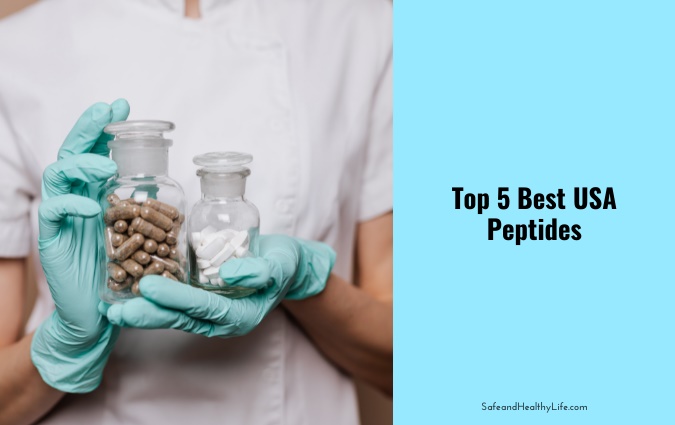
Lately, there has been a lot of focus on the working and benefits of the peptides.
The benefits of peptides for health, muscles, and skin have received an overwhelming response from the masses.
What are peptides?
The human body makes peptides. Peptides are the amino acid strings that act as the building blocks for the composition of proteins.
Lab-made or synthetic peptides can easily mimic the proteins present in the body. Some of these peptides are already used as a medication for different conditions ranging from multiple sclerosis to even diabetes.
According to the research studies, different peptides can benefit the muscles, skin, and even bodyweight.
Some brands and companies have been trying to put peptides in their skincare products and different dietary supplementations.
Most commonly used peptides in the USA:
The USA has been a leading country to invest in health and skincare lately. Peptides are an emerging topic of discussion on account of their health benefits.
The most commonly used USA peptides are:
- BPC-157:
Body Protection Compound (BPC 157) is a peptide that consists of about 15 amino acids in a chain. Such sequences are rare in nature; therefore, they are prepared in laboratories. BPC-157 is a protective compound that is present in the human stomach.
The mechanism of action of BPC-157 is that it triggers the new blood vessels’ formation through angiogenesis.
Such activities help in promoting faster healing and cells regeneration. BPC-157 also exhibits the 4-hydroxynonenal mimicking effects to stimulate the cells of tendons ad muscles.
- Melanotan-2:
Melanotan-2 is a peptide similar to the natural melanocyte-stimulating hormone in the body. This hormone helps in the increased production of the pigments for skin tanning and induced pigmentation.
Moreover, Melanotan-2 also helps in its work to stimulate the function of sexual organs and the brain.
- Bremelanotide PT-141:
PT-141 is a synthetic peptide that helps treat sexual dysfunctions among women and men. Bremelanotide PT-141 is a melanocortin molecule that binds to the melanocortin receptors and activates them. These receptors have a role in inducing skin tanning and dark pigmentation.
Together with Melanotan-2, these peptides have an effective prognosis for penile erection and sexual functioning among men and women, respectively. These peptides tend to stimulate the brain regions involved in sexual desires directly.
- GnRH agonist:
GnRH or Triptorelin is a potent peptide for the intervention and palliative care in advanced-stage prostate cancer. Triptorelin is the lab-made decapeptide agonist, LHRH (luteinizing hormone-releasing hormone) analog.
Triptorelin can repress the secretion of gonadotrophins for patients suffering from reproductive pathologies.
A chronic and constant administration of Triptorelin can decrease the production of FSH, LH, ovarian, and testicular steroidogenesis.
- Follistatin-344:
Follistatin-344 is the glycoprotein directly produced by the FS (folliculostellate) cells of the anterior pituitary. The main function of the follistatin-344 is to bind to and bio-neutralize the TGF-B family.
According to scientific evidence, follistatin-344 can increase the quantity of lean muscle mass, improve strength, and enhance performance. The potent anti-catabolic properties of follistatin-344 help prevent the loss of muscle mass.
Hair follicle density is also improved through the constant use of follistatin-344. Excess body fat is significantly reducible via the continuous use of follistatin-344.
Moreover, some researches also show the role of follistatin-344 in treating different types of cancers.
Benefits of peptides:
As discussed earlier, the commonly used USA peptides have different benefits and advantages for human health.
In general, a few most common benefits of peptides are:
Anti-aging effects:
- Increased production of collagen, proteins, and elastin in the skin
- Increased production of melanin through the properties of (AMP) antimicrobial peptide
Muscle growth:
Collagen and creatine peptides help in boosting the growth of the muscle and their repairing activities. These synthetic peptides are strongly associated with the improved secretion of growth hormone-releasing peptides.
Antioxidants:
Antioxidants are those agents which protect the skin against oxidative damage from free radicals. Antioxidants neutralize the effects of harmful ROS species to repair skin damage. Most skin products are now containing potent antioxidants to boost skin health.
Oral supplementations:
By far, the best route of peptide administration is oral supplementation. However, supplementation alone can’t produce effective results. You need to take care of the supporting diet and lifestyle to benefit from the peptides maximally. As peptides increase protein production, you need extra physical activity to keep the metabolism working. The best supplements for weight management are follistatin and BPC-157.
Side-effects:
The recommended dosage of the supplements is safe for consumption as per the body and age requirements.
Takeaway:
Peptides are the new talk of the town due to their exceptional effects on the body. A few most commonly used peptides have fewer side effects and more benefits for the body. A correct prescription and dosage of the peptides can help the individuals with maximum benefits.
References:
- Seiwerth, S., Sikiric, P., Grabarevic, Z., Zoricic, I., Hanzevacki, M., Ljubanovic, D., … & Kolega, Z. (1997). BPC 157’s effect on healing. Journal of Physiology-Paris, 91(3-5), 173-178.
- Langan, E. A., & Rhodes, L. E. (2011). Melanotropic peptides: what exactly is meant by” Melanotan”?. Acta Dermato Venereologica, 91(3), 377.
- Hedlund, P. (2004). PT-141 Palatin. Current opinion in investigational drugs (London, England: 2000), 5(4), 456-462.
- Tukun, Feng-Ling, et al. “Recent development of non-peptide GnRH antagonists.” Molecules12 (2017): 2188.
- Chang, F., Fang, R., Wang, M., Zhao, X., Chang, W., Zhang, Z., … & Meng, Q. (2017). The transgenic expression of human follistatin-344 increases skeletal muscle mass in pigs. Transgenic Research, 26(1), 25-36.




